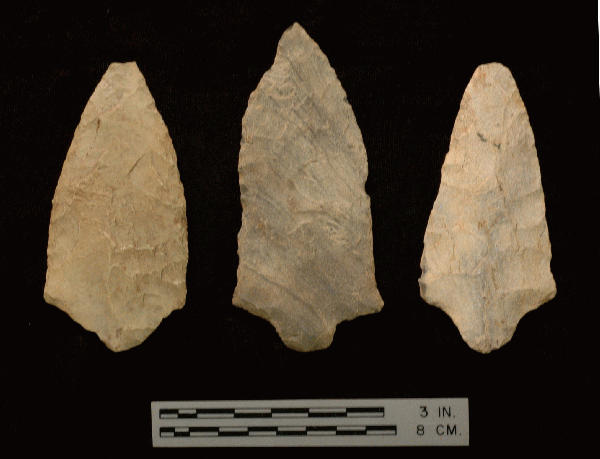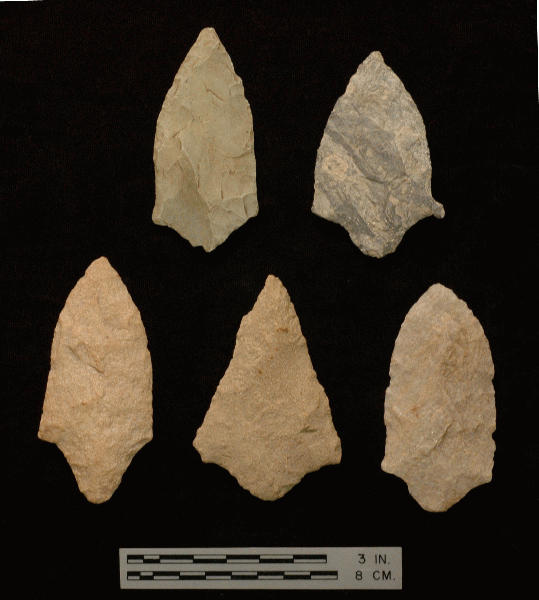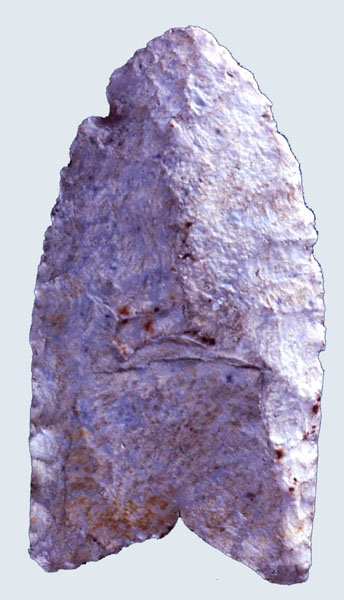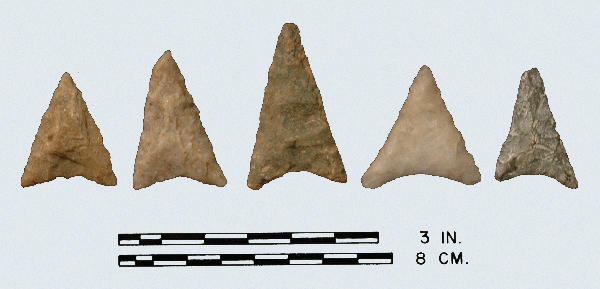
Cattle Run: tuff, rhyolite, rhyolite.

Cattle Run: Top Row: tuff, rhyolite; Bottom Row: all quartzite.
Type Tapering Late-Archaic
Defining Attributes
The Cattle Run is a large, well made, broad ovate to lanceolate-bladed point/tool. It has a distinctly short, contracting stem which terminates in a straight to excurvate shaped base.
Chronology
The Cattle Run point dates to the Late Archaic period, probably 2000 to 1200 BCE.
Description
- Blade: The blade size and shape can range from a longer, narrower lanceolate form to larger and medium sized ovate form. The blade is well made and has been thinned. The edges of the blade are typically well shaped to remove irregularities along the edge produced in the manufacturing process.
- Base: A short contracting stem terminates into a straight to excurvate-shaped base. The base is thinned, and the edge of the base is often ground. Typically, the base joins with the stem in a manner that makes the flow of the elements appear continuous. Laterally extending barbs do occur, but most often there is a distinct shoulder formed at the point of junction of the blade and stem. The stem is consistently short regardless of variation in shape and size of the blade.
- Size: Length ranges from 50 to 175 mm. Width ranges from 31 to 100 mm. Thickness ranges from 5 to 15 mm
- Technique of manufacture: At the Cattle Run Site, Geier (1996) noted that it is possible that the blades of these tools were finished as one of the later stages of manufacture after the haft (stem) had already been prepared. Also, Geier explains that these tools/points may have been re-sharpened or re-worked resulting in multiple shapes or functions before finally being discarded. McAvoy (1997) noted that the point was manufactured by soft percussion with little or no pressure retouch. The flakes are very wide and overlap at the center of the blade.
Discussion
Geier (1996) identified this type at the Cattle Run Site in Chesterfield County, Virginia as a stylistic variant of the local Savannah River tradition. Geier noted that these points exhibited blade range characteristics of the Savannah River type originally defined by Coe (1964), except these points possessed a very short, rounded “bathtub shaped haft element.” Of the 36 points of this type recovered from the Cattle Run Site, 21 were found in direct association with points of a more traditional Savannah River type. The Cattle Run point is similar to the Koens-Crispin point in New Jersey (Cross 1941). McAvoy (1997) described a similar point, called Island Swamp, from research along the Nottoway River in Virginia. The Cattle Run point is the widest biface made in Virginia, considerable wider than most Savannah River points. It took great flint knapping ability to manufacture such a point.
Defined in Literature
This type was originally defined by Geier (1996) based on points recovered from the Cattle Run Site (44CF257) in Chesterfield County, Virginia. Variations among the Savannah River type were previously noted (Coe 1964, Claflin 1931) but this specific variant was never formally defined as a type until 1996.
References



